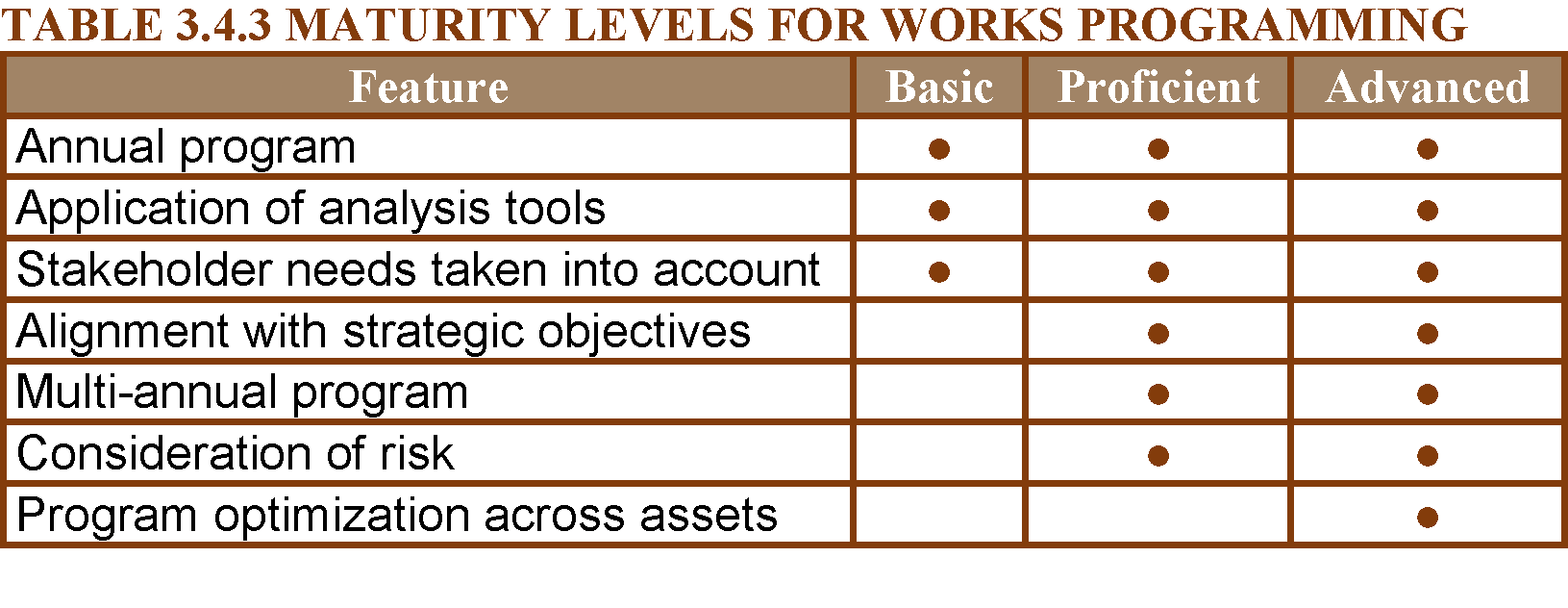

The level of maturity for works programming can be assessed based on a number of features, such as the length of the programming period, application of analysis tools, or resource distribution across asset classes. In this way, for each maturity level a particular feature may or may not be present, as shown in Table 3.4.3. Maturity levels can then be characterized by the set of features they support.

The following sections present a brief discussion of maturity levels with regard to the programming process.
A basic approach to programming normally allows for the production of annual works programs only. At this maturity level, organizational barriers still exist that limit the use of strategic objectives and other elements of planning to support longer programming periods. Another restricting factor for the development of multi-annual programs is a high level of uncertainty with respect to future revenue.
Though analysis tools are present at the basic maturity level, organizations at this stage tend to privilege the implementation of such tools over the improvement of the business process they should support, thus reducing the potential impact that tool use may have on the overall performance of the organization. Nevertheless, at this level return on investment might be used as a basis for decision making when this capability is built into the tools employed.
Also, at the basic level performance models within management systems are frequently not developed or calibrated to an appropriate degree to ensure that local conditions are properly simulated. In this respect, it should be emphasized that all performance models used in asset management systems (road deterioration, traffic assignment, vehicle operating costs, etc.) should be carefully adjusted to local conditions. Using default models, as is done in a number of countries due to economic or technical issues, should be discouraged if not prohibited because all medium- and long-term results from studies such as benefit-cost analysis or risk analysis are strongly dependent on the relevance of the models.
Most management systems in operation at the basic level support works programming only for pavements and, to a lesser extent, for bridges. Budget allocation for assets other than pavements or bridges are often carried out based on historical expenses.
Finally, because management of stakeholders’ expectations is usually also at an early stage, pressure may arise to favor projects addressing the needs of specific groups or projects with special political significance at the expense of other projects with better potential to achieve the goals of the road organization.
A distinctive feature of proficient organizations with respect to works programming is their ability to support development of multi-year work programs. These organizations have typically succeeded in reaching a proficient level in other aspects of asset management, including data management, lifecycle planning, and performance management.
The above is evidenced by the existence of more reliable information and tools. These allow road managers to expand the programming time horizon, which is also leveraged by an increased commitment from senior executives to use business cases effectively in securing funds for road investment over longer periods.
Pavement and bridge management systems are well established as corporate tools, and their application is aligned with the business processes the agency has implemented for allocating resources. Other systems for managing slopes and/or embankments, accidents, and signs may have already been deployed. Evaluation and prioritization of treatment options are based on benefit-cost analysis, particularly in the case of pavements.
At the proficient level, risk is used as an additional criterion to identify and prioritize candidate projects for assets such as bridges, earthworks, and drainage or for projects related to road safety. Risk may also be taken into account to manage sources of uncertainty affecting program delivery, including costs, funding levels, and adverse environmental events. Risk management is an additional factor enabling the agency to prepare multi-year works programs.
This level also features mechanisms for managing stakeholder expectations so that the needs of particular groups are properly balanced with the strategic objectives of the road organization. At the same time, new means for capturing customer perception, such as road user surveys, are put into practice.
Organizations at this stage of maturity have successfully incorporated asset management into their corporate culture and are immersed in a continuous improvement process. In this context, they investigate further actions to enhance the efficacy and efficiency of their business practices.
One of these actions is the implementation of a cross-asset schema for budget allocation, which broadens the scope of project selection and prioritization to ensure that projects that best contribute to the organization’s mission are adequately funded, regardless of the asset class or operational feature each project is related to. A prerequisite for an organization to implement cross-asset resource allocation procedures is the existence of a suitable organizational structure for allowing the steady flow of information that might be required.
Cross-asset methods are still at an early stage of development worldwide. In this regard, risk-based approaches have also proven useful for organizations already engaged in adopting such methods.
Advanced works programming is closely linked to asset management financial planning. On the one hand, financial planning takes as input information regarding historical funding levels and the amount of funds expected to be available in the foreseeable future (FHWA 2013). On the other hand, it defines how these funds will be allocated in the short to medium term.